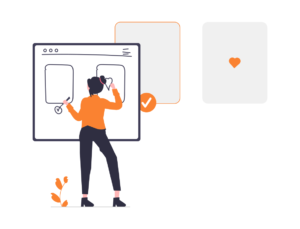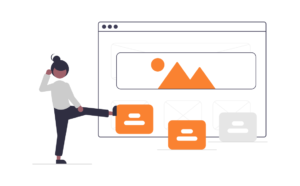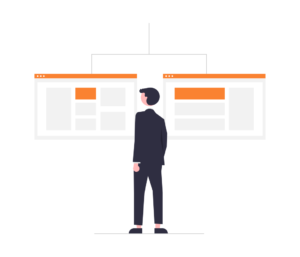Table of content

What is UX in Web Development?
User Experience (UX) in web development refers to the journey a user encounters when navigating a website or web application. UX encompasses the visual design, usability, accessibility, performance, and emotional responses during the interaction.
The impact of UX in web development is significant. A well-crafted UX boosts user satisfaction, engagement, and loyalty. It can increase conversions, retention rates, and overall brand perception. Conversely, poor UX frustrates users, leading to site abandonment and negative feedback.
Although UX and UI (User Interface) are often confused, they are distinct. UI covers visual elements like buttons, menus, and layouts. UX in web design includes UI, as well as aspects like information architecture, usability, and overall satisfaction.
A superior UX ensures a website or app is intuitive, efficient, and delightful to use. It addresses users’ needs, goals, and behaviour patterns, providing a seamless and enjoyable experience that solves real problems.
Key Components of UX Design
User Research
User research is vital for understanding the needs, behaviours, and pain points of target users. Techniques include user interviews, surveys, usability testing, and analytics analysis. Understanding the user helps designers create solutions that provide a seamless experience.
Information Architecture (IA)
IA focuses on organising and structuring content logically. Well-designed IA ensures users find what they need quickly and efficiently, avoiding frustration. This involves creating intuitive navigation systems, categorising content sensibly, and establishing clear labelling.
Interaction Design
Interaction design aims to create interfaces that facilitate user interactions. It involves designing layouts, controls, and feedback mechanisms. Interaction designers follow usability heuristics, accessibility guidelines, and design patterns to ensure interfaces are easy to use.
UX Design Process
The UX design process in web development is a structured approach, involving several phases to create user-centred products.
Discovery and Research
This phase gathers insights into the user’s context, goals, and pain points. Activities include:
- User interviews and surveys
- Contextual observations and field studies
- Competitive analysis
- Market research and trend analysis
Researching the target audience’s behaviours helps UX designers pinpoint opportunities for innovation.
Wireframing and Prototyping
Post-research, designers create visual representations of the product. This stage involves:
- Developing low-fidelity wireframes to outline structure and flow
- Creating interactive prototypes to simulate the user experience
- Iterating designs based on feedback and usability testing
Wireframes and prototypes help explore and validate ideas before final development.
User Testing and Iteration
This phase involves:
- Usability tests with representative users
- Gathering qualitative and quantitative data on user behaviour
- Analysing results and identifying areas for improvement
Designers iterate on designs, refining the user experience until it aligns with desired goals and standards.
Frontend Development and UX

Responsive Design
In modern web development, responsive design is crucial. Users access websites from various devices with different screen sizes. Responsive design ensures websites adapt, providing optimal viewing experiences across all platforms.
Accessibility
Accessibility ensures equal access for users with disabilities. Adhering to accessibility guidelines and best practices includes proper semantics, alternative text for images, keyboard accessibility, maintaining colour contrast, and accessible navigation.
Performance Optimisation
Website performance affects UX significantly. Slow-loading pages lead to frustration. To optimise performance, minimise and compress code, optimise images, leverage browser caching, implement lazy loading, and use performance monitoring tools.
Backend Development and UX
Data Architecture
Efficient data architecture ensures faster load times and smoother interactions. Proper organisation supports features like personalisation, recommendations, and search functionality, enhancing the user experience.
Security and Privacy
A robust backend with strong security measures is key. Implement secure authentication, encryption, and access controls to protect user information and foster trust.
Third-Party Integrations
Integrating third-party services and APIs enhances functionality. Examples are payment gateways, social media, and mapping services. These integrations must be managed to ensure seamless performance.
Whether frontend or backend development, prioritising UX in web development creates a consistent and engaging user experience. By considering UX factors, developers can produce robust systems that elevate the user journey. Remember, we are here to support you every step of the way.
Hiring a UX Designer

When hiring a UX designer, evaluate their portfolio and design thinking process.
Ensure they have strong technical skills.
A robust portfolio shows their ability to solve real problems with effective UX solutions.
The design thinking process involves empathising with users, defining problems, ideating solutions,
prototyping, and refining designs based on feedback.
Technical skills should include knowledge of front-end technologies like HTML, CSS, and JavaScript,
along with familiarity with tools like Sketch, Figma, or Adobe XD.
Communication and collaboration abilities are also essential.
The Importance of UX in Business Growth
Prioritising UX in web development can significantly impact business success and growth.
UX in web development leads to improved user satisfaction, increased conversions, and higher revenue.
Improved User Satisfaction
Excellent UX ensures seamless, intuitive, and efficient navigation.
Positive user experiences lead to satisfaction, engagement, loyalty, and brand advocacy.
Satisfied users are likely to return and recommend the website.
Increased Conversions and Revenue
Well-designed UX can boost conversion rates.
A smooth user journey, reduced friction, and optimised checkout processes increase the likelihood of users completing desired actions.
Small improvements in conversion rates can lead to significant revenue gains, especially for high-traffic websites.
Competitive Advantage
User experience can differentiate a business from its competitors.
Companies prioritising UX are likely to attract and retain customers, fostering loyalty and advocacy.
A superior UX is a sustainable competitive advantage and challenging to replicate.
Investing in UX in web development can unlock substantial benefits, driving business growth, customer loyalty, and long-term success.
Which is More Important? UI vs UX

User interface (UI) and user experience (UX) are closely intertwined but distinct.
UI focuses on visual and interactive elements, while UX encompasses the entire user journey.
Both UI and UX work together to create a cohesive experience.
UI is the tangible manifestation of UX design. However, UX lays the foundation guiding UI decisions.
UX in web development involves research, analysis, and strategic planning to understand user needs and behaviours.
A well-designed UX ensures the product meets both functional and emotional needs.
While a stunning UI can attract users, UX determines long-term engagement and value.
A product with poor UX will likely frustrate users despite a beautiful UI.
Conversely, a product with great UX but a subpar UI may struggle to captivate users.
Both UI and UX are crucial for success. They must harmonise, with UX laying the foundation and UI bringing it to life.
UX Best Practices and Trends
Mobile-First Design
Mobile devices are becoming the primary means of accessing the internet.
Mobile-first design prioritises responsive layouts, intuitive navigation, and efficient use of screen space.
This approach ensures websites are accessible and usable on the go, enhancing satisfaction and engagement.
Personalisation and Customisation
Leveraging user data, websites can adapt content and functionality to individual needs.
Personalisation enhances user experience and fosters a deeper connection with the product.
Examples include displaying relevant content or allowing users to configure settings and layouts.
Artificial Intelligence and Machine Learning
AI and ML revolutionise UX design by enabling websites to learn from user behaviour and provide intelligent recommendations.
Applications include chatbots, predictive analytics, and intelligent search engines.
AI and ML enhance usability and provide more intuitive interactions.
The Future of UX in Web Development
The future of UX is dynamic, driven by emerging technologies, ethical considerations, and continuous improvement.
Ethical Design and Inclusivity
Ethical design and inclusivity will be paramount.
Consider factors like accessibility for users with disabilities, cultural sensitivity, and privacy protection.
Ethical design extends to minimising digital addiction and promoting sustainable practices.
Continuous Improvement and Iteration
Embracing continuous improvement ensures designs remain relevant.
Agile methodologies, analytics, and user feedback loops enable rapid prototyping, testing, and refinement.
This approach enhances user experience and aligns with evolving trends.
By adopting these practices, web developers can future-proof their products and deliver exceptional user experiences through robust UX in web development.

 Resources
Resources


























